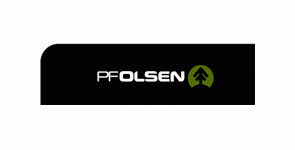

December saw modest increases in unpruned export log prices driven by slightly favourable movements in exchange rate and ocean freight rates.
Export pruned log prices lifted on average about $8/JAS m3.
Domestic prices were steady as most prices are set on a quarterly basis.
In this report we reaffirm how important housing markets are to the demand for wood products. However we note that the way the wood is used, and how much is used, is starkly different between the main markets affecting New Zealand’s wood products.
The two photos later in the report contrast how wood products are principally used in housing in China compared to housing in most developed western economies.
Export Log Market
CFR price (the US$ price of logs landed at the destination port) is steady but was offset by a small favourable change in exchange rate and a slight fall in ocean freight rates. Ocean freight rates have benefited greatly from big falls in oil price this year which flows through to lower bunker prices.
Strong demand and CFR price increases for pruned logs resulted in solid gains in export pruned log price, with prices rising as much as $20 at one port.
We have observed and are hearing more reporting of considerable investment in China in pruned log processing – mainly sawmills and drying kilns. This is for the manufacture of clear edge-glued solid wood panels, clear boards and furniture such as baby cots. These are destined for both domestic (China) and overseas (e.g. South Korea and USA) markets.
This is expected to result in increased demand for pruned Radiata pine logs from New Zealand and put upward pressure on price. This is an interesting side-story and provides useful market diversification to the otherwise housing-centric demand for wood products in China.
One constraint, however, is that these logs need to be sapstain free to get a premium price; this is only possible (with any reliability) when exporting from ports in New Zealand with debarking and anti-sapstain treatment facilities – namely Marsden Point, Gisborne and Tauranga.
Exports of pruned logs with bark on (untreated) are generally priced $8-$10/JAS m3 less than debarked and treated logs.
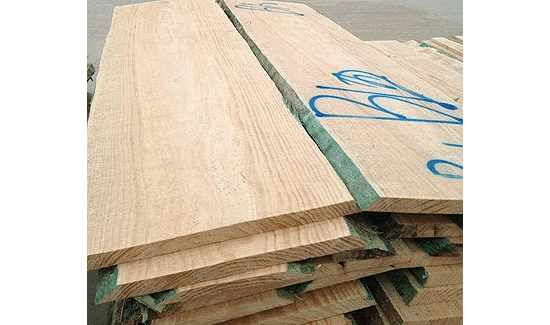
Photo of clear boards cut in China from sapstain-free Radiata pine logs from New Zealand. Due to the susceptibility of Radiata pine to sapstain, reliable sapstain-free delivery of logs to overseas ports is only achievable by debarking and anti-sapstain treating logs on arrival to the New Zealand port. Only Marsden Point, Gisborne and Tauranga currently have such treatment facilities.
Log stocks in China continue to reduce across the 25 ports monitored. As at 21 November, total log stocks were reported at 3.28m m3, well down on the peak of 4.4m in July of this year. Average sales per day are reported to have jumped to 85,000 m3 per day resulting in a low 1.2 months of stocks. It should be noted, however, that this sales level is a big increase on October’s sales (of 58,000 m3 per day) and should be treated with caution until more data is available. Maybe the 30 September government support package is having a stimulatory impact on the Chinese housing market. This package included easing mortgage restrictions and loan ratios for owner-occupiers, more lenient credit for developers and extra funding for social housing/urban renewal.
While the housing market decline in China and lower economic growth is of concern to wood exporters (as reported last month), some 10-15 million people each year are moving from rural to urban living. And with wages increasing in the last five years at just under 15% per annum, more and more of the population are becoming more wealthy consumers. BNZ’s Tony Alexander sees the pull back in prior massive credit and apartment construction expansion as “merely digestion problems”. Whether the heartburn turns into more major heart problems will become more apparent in the New Year. Most are expecting a steady market through the beginning of 2015, with much short-term attention focused on the impact of Chinese New Year in February 2015.
India is continuing to provide a good, albeit small, market for lower grades, and Korean demand is steady, and providing useful options for shippers with deck cargoes that are not fumigated (Korea, unlike China, allows New Zealand to export unfumigated logs).
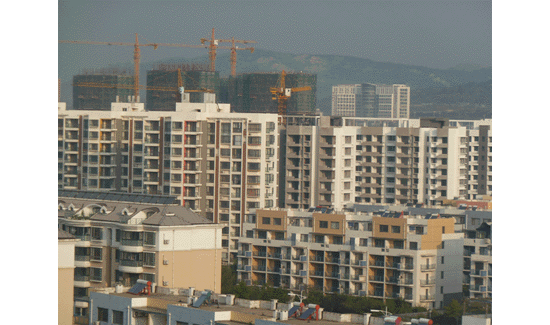
Housing markets are big drivers of demand for wood products. In China this relates mostly to the wood used in temporary construction support of steel-reinforced concrete structures. while the per-capital wood use is much lower than in traditional western housing, the sheer scale of it means globally significant demand for wood products.
Domestic Log Market
The New Zealand housing market continues with its head of steam, but the dual 'locomotives' are solidly Auckland and Christchurch with most other New Zealand towns and cities watching from the side-lines. Over the past year, new dwelling consents for Auckland are up 32%, Canterbury up 31% and the rest of New Zealand 9%. Where the influence of demographics/immigration (Auckland) and earthquake rebuild (Canterbury) are absent, housing is more reliant on agriculture and manufacturing for direction. while the large reductions in fuel costs will benefit New Zealand, the big fall in dairy prices will offset this (and some) for rural and provincial New Zealand.
New Zealand’s only publicly listed wood products manufacturer, Taupo-based Tenon Limited had its annual meeting in Wellington this month. Chairman, Luke Moriarty reported that the company is in 'good health' and is benefiting from the United States housing market recovery. The recent downturn in the U.S. housing market was so deep and prolonged that the recovery is expected to be long-lived as pent up demand drives the market higher. Clear board products are in particular demand and Tenon announced it would spend US$2m on a grade scanner and optimising cross—cut saw to lift recovering rates. This is on top of a prior commitment to spend US$5m on mill upgrade work. Tenon shares have jumped 57% since June last year.
Very strong employment data from the U.S. early this month has seen the Dow Jones Industrial Index rally strongly to challenge the 18,000 mark. This latest rally, which commenced at the end of October, has seen the Dow rise by over 12% in less than two months. It is reported that the U.S. economy added 235,000 jobs in November, beating consensus numbers by 87,000 and producing an unemployment rate of 5.8%. while boding well for exporters of wood products to the U.S., this news is also creating bullish sentiment for the green-back driven by expectations that the Federal Reserve will speed up interest rate hikes. This will make US$ denominated fixed interest investments more attractive. This caused the NZ$:US$ cross rate to drop to below 0.77 following the first weekend in December. This is a double benefit for exporters of wood products from New Zealand; more robust demand from a stronger U.S. housing market and higher NZ$ sales realisations from a more favourable exchange rate.
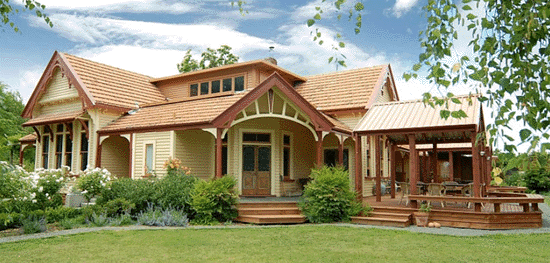
Housing markets are big drivers of demand for wood products. In most western economies this relates in large part both to the material the houses are built out of, as well as what is put into them. However, most of demand for New Zealand wood products relates to interior fit-out of new and renovated houses in the USA – boards, mouldings and some furniture.
Prospects in Australia are mixed. Steep falls in commodity and precious metals has resulted in not only a big decline in the mineral resources sector, it is also bringing in less tax revenue for the government. while house prices are generally very strong, there is only moderate growth in dwelling consent numbers and a declining trend in dwelling consent value. The strengthening NZ$:AU$ is also ill-affecting New Zealand wood products exporters’ NZ$ sales realisations.
On balance, the mix of an overall strong New Zealand and U.S. housing market and a dropping NZ$:US$ cross rate is favourable and a strong driver of wood products exporters prospects. Less favourable Australian conditions will affect some producers, although this market is continuing to reduce in importance as alternative markets are developed. Worsening economic prospects from the UK and the Eurozone will also affect some New Zealand wood product exporters as will the slowdown in the Chinese economy - albeit to a lesser extent.
Domestic pruned logs are currently in strong demand with indications of price increases in quarter one of 2015. Structural grades and pulp are steady as purchasers prepare for a shutdown for the Christmas break.
Domestic log prices were steady with little change from last month.
The PF Olsen log price index rose slightly from 103 to 104 this month. It is now 19 points above the cyclical low of 85 in November 2011 and 17 points above the last low of 87 in July of this year. The index is still 13 points below the March 2014 peak of 117 and just two points higher than the four year average of 102.
PF Olsen Log Price Index
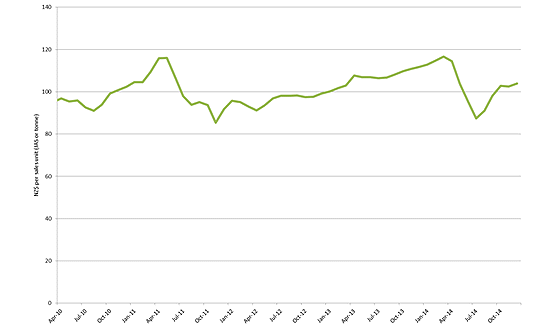
Basis of Index: This Index is based on prices in the table below weighted in proportions that represent a broad average of log grades produced from a typical pruned forest with an approximate mix of 40% domestic and 60% export supply.
Indicative Average Current Log Prices
| Log Grade | $/tonne at mill | $/JAS m3 at wharf |
| Pruned (P40) | 148 | 155 |
| Structural (S30) | 113 | |
| Structural (S20) | 97 | |
| Export A | 106 | |
| Export K | 100 | |
| Export KI | 91 | |
| Pulp | 48 |
Note: Actual prices will vary according to regional supply/demand balances, varying cost structures and grade variation. These prices should be used as a guide only and specific advice sought for individual forests.
---------------------------------------------------------------
This article is reproduced from PF Olsen's Wood Matters, with permission.
We welcome your comments below. If you are not already registered, please register to comment
Remember we welcome robust, respectful and insightful debate. We don't welcome abusive or defamatory comments and will de-register those repeatedly making such comments. Our current comment policy is here.